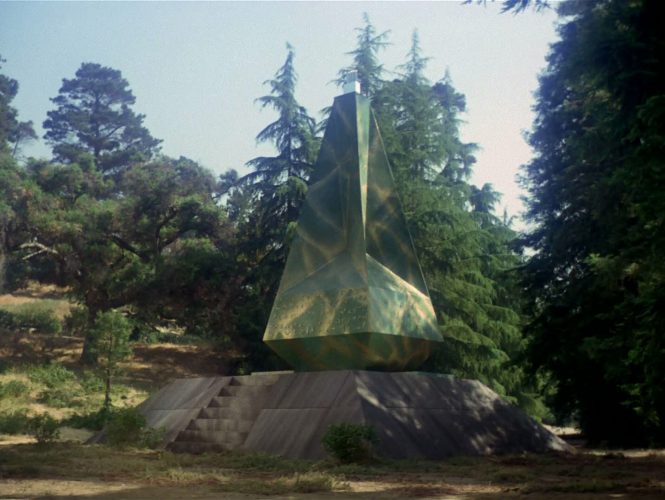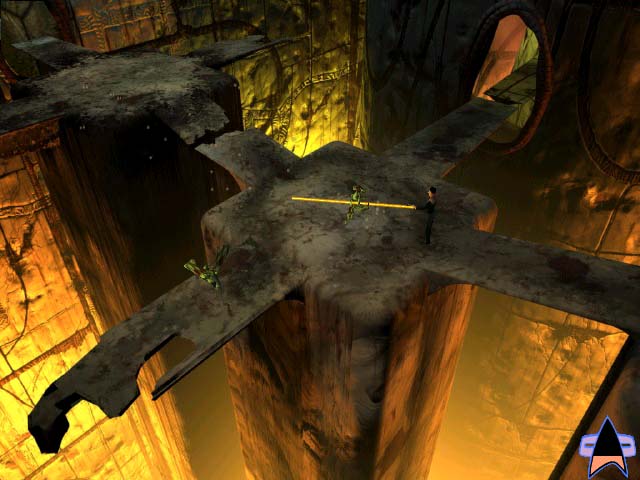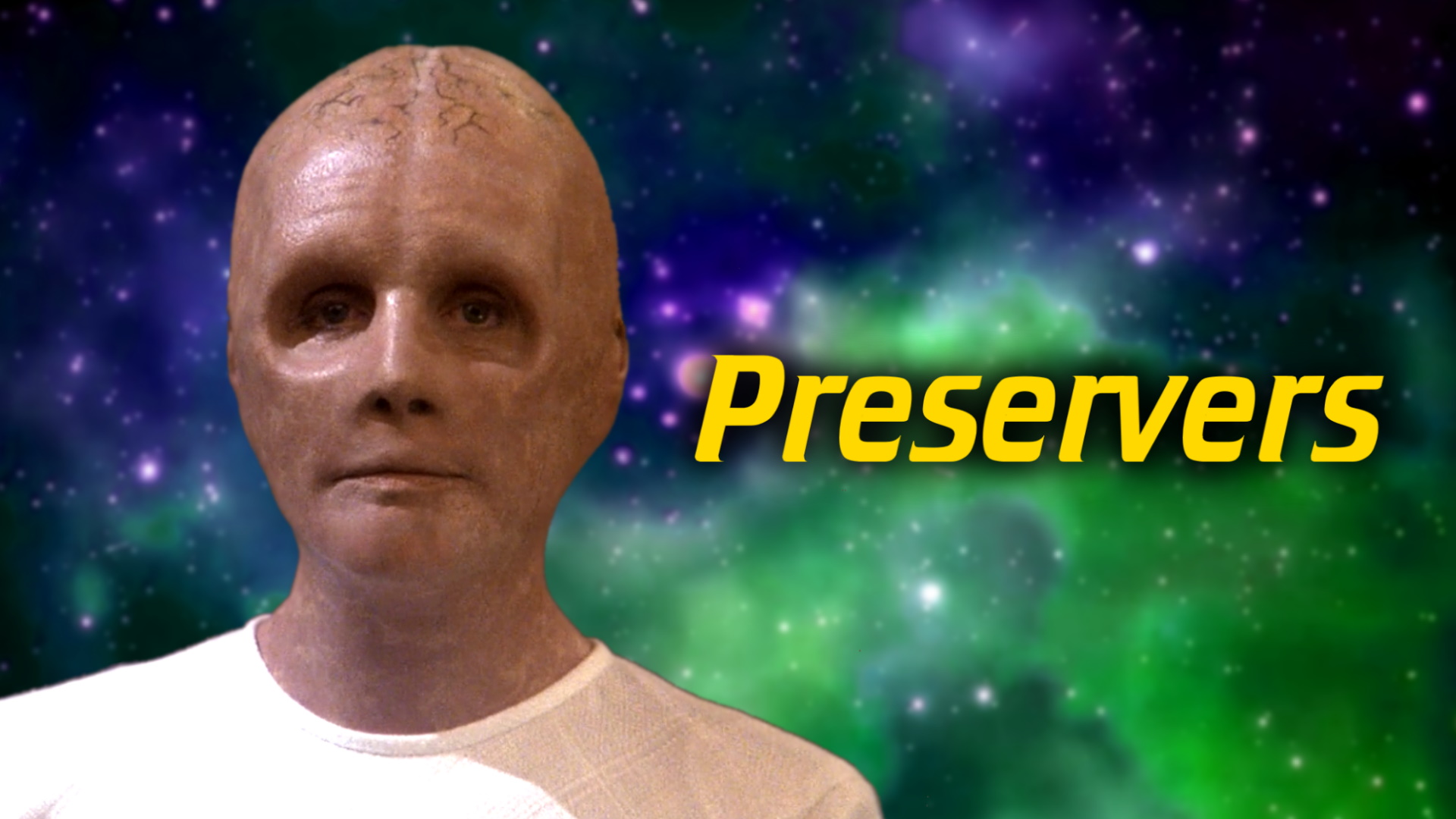Hey guys, what’s up? Tyler here. In Star Trek, the Preservers are referred to as a “super-race” who often rescued primitive cultures in danger of extinction and seeded them on other planets where they could thrive. The Preservers are first mentioned in canon in The Original Series episode “The Paradise Syndrome,” where the Enterprise crew visits the planet Amerind, home to a population of transplanted Native Americans. The Preservers have left an obelisk that acts as an asteroid deflector, as deciphered from Preserver writing present on the obelisk. Similar obelisks are found in other parts of the galaxy, pointing to widespread activity by the Preservers in the ancient past.
We don’t really hear any more mentions of the Preservers in canon, besides an offhand reference to an obelisk on a moon of Andoria in Discovery. But TNG writer Ronald D. Moore has commented on the possibility that the Preservers are the same species as the Ancient Humanoids seen in “The Chase.” These ancient humanoids are said to have seeded the galaxy with their genetic code 4.5 billion years ago, giving rise to humanoid life—which you’d know by now if you’ve watched literally any of my Trek videos this year. Suffice it to say, the Ancient Humanoids—referred to as the Progenitors in other materials—can be connected to virtually everything in Trek’s Milky Way.
In this video, I’ll attempt to construct a rough timeline of the Preservers and Progenitors’ existence, exploring the merits of the idea that they are the same species and giving serious consideration to the idea that they aren’t. I’ll also try to answer the question of where they ultimately ended up after seemingly disappearing from the galactic scene. This is: Star Trek’s Ancient Civilizations: The Preservers.

A Timeline
For the first part of this timeline, in order to avoid confusion, I’m going to be treating the Progenitors and Preservers as separate species instead of one and the same. The reason I’m doing this is because in all of the conflicting accounts of their ancient activities, while there’s some overlap, alternating between the two names can make us lose focus. At least, that’s the problem I encountered when writing the first draft of this video. But enough meta context—let’s explore the Progenitors first.
While it’s unknown *where* exactly the Progenitors first evolved, Star Trek: Star Charts places their origin point in the Gamma Quadrant. However, in Star Trek Online, it’s said that the Iconians—natives of the Beta Quadrant—were the first of the Progenitors’ children to achieve sentience, and references to them in other media place heavy emphasis on their activities in the Orion Arm of the Milky Way—a.k.a., our stellar neighborhood. Whichever the case, direct references to the Progenitors indicate their civilization lasted at least 500 million years.
As the sole Progenitor seen on screen describes in “The Chase,” when they first ventured out into space, they found no other life forms like themselves. Believing that the lifespan of a single species is finite, the Progenitors seeded the primordial oceans of millions of M-class worlds with a DNA sequence that would guide evolution towards a form similar to their own. Fragments of this DNA sequence would be found in the 24th century by the Enterprise-D in cooperation with the Klingons and Cardassians, and when put together, the fragments project a hologram message from the aforementioned Progenitor describing her species’ motives. Fun fact: the actress who plays the Progenitor is the same actress, Salome Jens, who played the Female Changeling in Deep Space Nine.
While some fans have taken issue with this explanation for why so many alien species in Trek are humanoid—essentially an in-universe explanation to justify a real-world production expense—I think it’s perfectly reasonable for the Star Trek universe, as it’s basically a glorified version of panspermia. Panspermia is the hypothesis that life can be distributed throughout the universe by space dust, asteroids, comets, and other natural means. In fact, since the 1970s we’ve observed that interstellar dust contains a large amount of organic molecules. Under ideal impact conditions—for example, in a body of water—space debris can spread microorganisms such as bacteria from planet to planet, and these lifeforms can colonize their new environment.
Paul Stamets makes a reference to panspermia in season 1 of Discovery, characterizing spores of the fungus Prototaxites stellaviatori as “the progenitors of panspermia.” These mycelial spores contain a subspace component that enables access to the mycelial network, the region of subspace used by Discovery’s experimental spore drive. It’s possible, then, that the Progenitors made use of the mycelial network as a distribution system for their DNA code, although this is highly speculative. In any case, the Progenitors seem to have stuck around in some capacity as there are numerous homeworlds of humanoid species that orbit stars younger than 4.5 billion years old. While some of these homeworlds may have been colonized by ancient astronauts, native born species on younger planets may have been seeded by remaining Progenitors, strengthening their connection with the Preservers.
Non-canon materials document some of the Progenitors’ activities towards the end of their species’ natural life cycle, such as the construction of a research base underneath the surface of Ba’Ku, a failed genetic experiment (a genophage, if you will) called the Xenophore Seed, and the collapse of their civilization at the hands of a malevolent dark matter entity. These events are said to have occurred around 4 billion years ago. In one of their last acts, the Progenitors may have constructed the Galactic Barrier to protect the Milky Way from outside threats, and the barrier—an energy field with unique properties—persists into the 23rd century and beyond.

Now, as far as the Preservers go, early licensed materials such as the Star Trek FASA RPG modules dated their origins at around 38,000 years ago in the Beta Quadrant. This precipitated a period known as the “Preserver Era” that lasted about 20 millennia, but this source is largely inaccurate in my view as it doesn’t really line up with what we learn from “The Paradise Syndrome.” Most Native American cultures emerged in the last ten thousand years, and the ones directly referenced in the episode—the Navajo, the Mohicans, and the Lenape (or Delaware)—have recorded histories that date back to around the mid-2nd millennium A.D.
Furthermore, the novel Federation by Judith and Garfield Reeves-Stevens—as well as the William Shatner novels, including Preserver—link the Progenitors and the Preservers, describing the latter’s history as spanning in excess of 2 billion years. Speculation exists about possible Borg-Preserver conflicts, possibly using the planet killers seen in “The Doomsday Machine,” though this is only one theory as to the origin of the Doomsday devices, which may have come from outside the galaxy. Anyway, other novels, comics, and even Star Trek Online posit Preserver involvement in the history of several races, including the Organians, Metrons, Aegis, Deferi, Capellans, Edosians, Vulcans, and others. According to the novel Ex Machina, they may have even been responsible for transplanting ancient Romans from Earth to the planet 892-IV seen in “Bread and Circuses,” meaning these Romans were not an example of parallel, convergent evolution but a literal continuation of the Roman Empire.
The Preservers would have gone by many different names as they came to be revered by the various races they protected. These names include the “Wise Ones,” as they’re called by the Amerindians, or, according to the Enterprise novel What Price Honor, the Anu’anshee, Krytallans, or Irakua as known in the Eris Alpha sector. The Star Trek Encyclopedia even speculates that Species 312, suspected builders of a protective energy barrier around the planet Ledos in the Delta Quadrant, might have been the Preservers as well. This would indicate that at least some Preservers were assimilated by the Borg Collective. The point is that the Preservers have been involved in galactic affairs off and on, alternating between periods of dense activity and more dormant states, for potentially up to 4.5 billion years. They’ve left all kinds of artifacts, including technology that, when interfaced in a particular way, points to their ancient origins and reveals the truth about their species.
So, does all this add up to the Progenitors and the Preservers being the same species? Well, maybe, maybe not. The connection was supposedly part of the plans for the unproduced Trek TV series Star Trek: Federation, but despite this and Ronald D. Moore’s claims, there’s little in canon to back it up. Certainly, the time differences involved—4.5 billion years ago versus mere centuries—seem to indicate they are different races. It arguably also contradicts the theme of the Progenitors’ children outliving them as that was the original motive behind their genetic seeding program. Some have attempted to link the Preservers with Sargon’s species from “Return to Tomorrow,” meaning the Preservers may have been Vulcanoid in appearance—but given the cataclysm that befell Sargon’s people half a million years ago, the Preservers would have to be an enclave that survived in secret.
We don’t know much, if anything, about where most of the Preservers are now. They may have eventually left the galaxy for parts unknown—and depending on the date, this could tie in with another interesting aspect of The Original Series that has largely been overlooked. The planet Mudd in the episode “I, Mudd” is populated with humanoid androids whose creators originated from the Andromeda Galaxy. These extragalactic beings had established outposts in the Milky Way before their sun went nova, and the androids have been chilling here ever since. Harry Mudd was the first lifeform from the Milky Way who encountered these androids—meaning that The Original Series is on record as having established the humanoid form is not exclusive to our galaxy.
It’s incredibly likely, then, that the Preservers would have had the technology to travel beyond the Milky Way—and beyond the Galactic Barrier, for that matter—and might have spread their genetic code to other worlds throughout the Local Group. We haven’t seen much of other galaxies in Star Trek, and most extragalactic beings seen throughout the franchise are nonhumanoid in appearance. That said, the possibility that both forms of life—humanoid and nonhumanoid—are common throughout the Local Group, or at least not completely absent, is fascinating to me. This would mean the Preservers’ legacy isn’t necessarily confined to our galaxy…who knows how far it truly reaches? Is it possible that they’ve ascended into noncorporeal beings like the Organians, Metrons, and the Q? There’s no way to know for sure. But as humans and our interstellar neighbors continue to advance far into the future of the Star Trek timeline, it’s these and other mysteries that I can see us finding the answers to.
Alright, a quick recap:
- The Progenitors first arise on a planet in an unspecified part of the galaxy 4.5 billion years ago.
- Within the first half-billion years of their existence, they’ve reached virtually every corner of the galaxy and may have had bases of operation on various planets, including Ba’Ku. According to some accounts, around this time, their civilization is crippled by a failed biological experiment and possibly extragalactic threats. They supposedly create the Galactic Barrier to protect their children.
- Around 2 billion years ago, surviving members of this race—the Preservers—continue to cultivate the evolution of younger races. According to one theory, one of their creations, an early incarnation or possibly time-traveling faction of the Borg, fight the Preservers in a war that the Preservers ultimately lose.
- Another resurgence sees Preserver involvement in the evolution of the Organians and the Metrons, among other races. This probably happened millions of years ago when the Organians first evolved.
- Half a million years ago, the Arret Empire is founded by Sargon’s people, an offshoot of whom may have become the Preservers if their connection with the Progenitors is to be ignored.
- Tens of thousands of years ago, by one account, the Preservers ally with the Aegis—Gary Seven’s superiors from the episode “Assignment: Earth”—to protect the galaxy from threats across both space and time.
- Within the last ten thousand years, the Preservers conduct their only known canon activity to date, which is transplanting members of the human race to the planet Amerind and leave behind a powerful obelisk, although similar obelisks are discovered in the Andorian system and, according to various non-canon sources, ruins are found on Altair and other planets in local space.
- Finally, in the 24th century, speculation continues to ensue about connections between the Progenitors and Preservers, with direct interference in the evolution of the Deferi, Edosians, Vulcanoid races, and several other species the subject of archaeological interest.
Admittedly, this timeline isn’t perfect, but believe me, I’m leaving out some information that I consider to be super-contradictory to what we see on screen. And as always, just like with the various accounts of the Borg’s origins across different media, it’s possible that large parts of this timeline could be dismissed as they lack evidence in canon. But I think on principle, because of what we know even IN canon about the Progenitors and the Preservers, there’s a bit more leeway in explaining various archaeological finds and other galactic mysteries with the phrase “the Preservers did it,” because in a lot of instances, THEY ACTUALLY DID.
Watch Orange River Media’s Video
Thank you all so much for watching! I’m interested to hear your thoughts in the comments. If you haven’t yet subscribed, be sure to do that as well so you won’t miss future uploads and click the bell icon to receive all notifications. If you want to support my work even further, becoming a YouTube member or a patron at patreon.com/orangeriver is a great way to do so. I’ll see you in the next video… live long and prosper.
YouTube: https://www.youtube.com/orangeriver
Twitter: https://www.twitter.com/orangerivernw
Instagram: https://www.instagram.com/orangeriver.nw
Facebook: https://www.facebook.com/orangerivernw
Patreon: https://www.patreon.com/orangeriver












